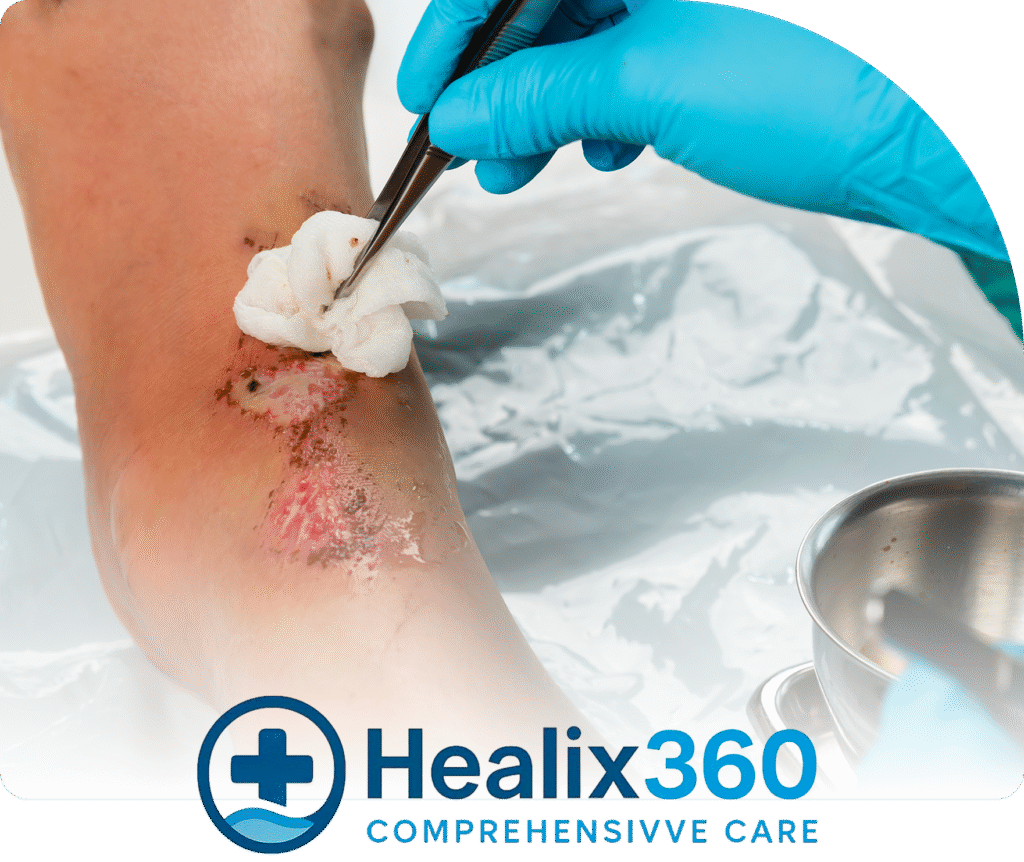Advanced Healing for Chronic Wounds





Here’s how they work step by step

Here’s how they work step by step
When stem cells are applied to a chronic wound, they immediately begin secreting signaling molecules—called cytokines, chemokines, and growth factors—that “call in” the patient’s own cells. These signals tell the surrounding tissue to shift from a state of inflammation (where the wound is stuck) to a state of repair.

Reduction of Inflammation
Chronic wounds are usually inflamed for far too long. Stem cells have natural immunomodulatory properties—they calm excessive inflammation, which otherwise destroys tissue and prevents healing. This creates a more balanced environment where regeneration can begin.

Formation of New Blood Vessels (Angiogenesis)
Stem cells release vascular endothelial growth factor (VEGF) and other substances that stimulate the body to grow tiny new capillaries within the wound bed. These blood vessels bring in oxygen and nutrients, creating a fertile foundation for tissue repair.

Stimulation of Collagen and Extracellular Matrix
A wound needs a scaffold to close properly. Stem cells encourage fibroblasts (the cells that make connective tissue) to produce collagen and rebuild the extracellular matrix, the structure that holds everything together.

Direct Tissue Regeneration
In some cases, stem cells can actually transform into skin cells (keratinocytes), fibroblasts, or endothelial cells themselves, directly contributing to the wound’s closure. The result: tissue that is stronger, healthier, and less prone to breakdown

Long-Term Remodeling
Even after the wound closes, stem cells continue to influence the area by reducing scar tissue formation and improving the overall quality of the healed skin.

Behind the scenes, our medical team works with trusted wound care professionals who share our dedication to innovation and results. Every specialist we coordinate with has advanced experience in regenerative medicine and a proven track record of helping patients heal faster and avoid serious complications. This allows us to deliver care with confidence, knowing patients receive the highest quality treatment supported by modern biologics and advanced wound care techniques.

How Stem Cells Work in Wound Healing
Why Amniotic Membranes Work So Well

Natural Biological Scaffold
The membrane itself acts like a natural dressing, providing a ready-made scaffold for new tissue to grow on. It mimics the extracellular matrix your body would normally build, allowing skin cells to migrate and cover the wound.
Loaded with Growth Factors
Amniotic tissue is rich in epidermal growth factor (EGF), transforming growth factor (TGF-β), and other molecules that directly stimulate cell division and tissue regeneration. These factors dramatically accelerate healing compared to a standard dressing.
Anti-Inflammatory & Anti-Scarring
Amniotic membranes naturally reduce inflammation and help minimize scar formation. They also contain hyaluronic acid, which keeps the wound environment moist and conducive to repair.
Protection from Infection
The graft forms a physical barrier over the wound, protecting it from bacteria and reducing infection risk while still allowing oxygen flow.


Amniotic Membranes
About Amniotic Membranes and Why They Are So Effective
What does our customer say?

Satisfy Solution
Patient-Friendly Benefits of Amniotic Membrane Grafts

Lightweight, Thin, and Comfortable:
The membrane feels like a delicate layer of tissue. It doesn’t add bulk or discomfort.

No Stitches or Glue Needed:
These grafts naturally adhere to your wound without the need for sutures or messy adhesives.

Covered by Medicare Part B:
Most patients can receive these advanced grafts without financial burden because they are reimbursed by Medicare Part B.

Packed with Healing and Growth Factors:
These membranes bring exactly what the wound needs—natural proteins, cytokines, and other building blocks for repair.

Flexible and Form-Fitting:
Whether the wound is on a foot, leg, or another area, the graft molds easily to the shape of the wound bed.

Available in Multiple Sizes:
Grafts can be customized to fit small or large wounds, ensuring efficient use and optimal coverage.
The Big Picture
When stem cell therapy and amniotic membrane grafts are used together, they create a
powerful synergy—stem cells stimulate your body’s repair mechanisms, while the amniotic
membrane provides the physical and biological foundation for new tissue to grow. For
patients struggling with non-healing wounds, this combination has transformed care
outcomes, leading to faster closures, reduced pain, fewer infections, and a dramatically
improved quality of life.



